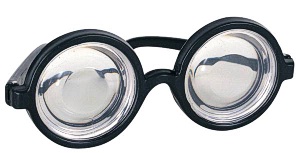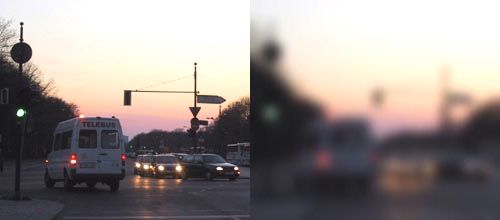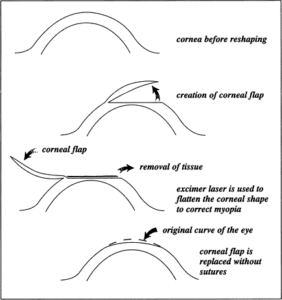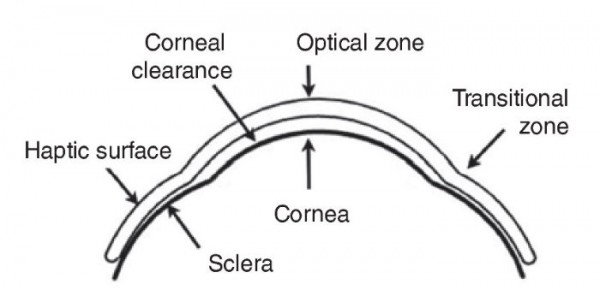Five years ago, on June 2, 2008, I underwent brain surgery: microvascular decompression of the seventh cranial nerve in an attempt to cure hemifacial spasm. Unfortunately my facial nerve was damaged during surgery and I awoke with left side facial paralysis; I could neither smile nor blink, and my eye no longer produced tears. In addition to the trauma of losing my pretty smile, I experienced extreme pain from dry eye. Over time the nerve healed. I have recovered quite a bit of facial function. My smile is not what it used to be, but most people don’t notice that anything is wrong. I’ve learned how to make a smaller smile to minimize the difference between sides. I now produce tears when I cry or eat spicy food, but not under normal circumstances. I have tried every type of eye drop and gel I could find, but Refresh PM ointment is the only one that keeps dry eye pain at bay. My brain learned to compensate for the blurry vision on the left side, but over time it became mentally exhausting. This is the story of my nearly lifelong quest for sharp vision. It’s long and a bit on the clinical side now and then, but I feel it is important to be as thorough as possible in case it can help someone else out there.
I grew up nearsighted. In third grade I failed the school vision screening and made my first visit to an ophthalmologist. I remember leaving the optical shop after getting my first pair of glasses and marveling at seeing individual leaves on the trees. I was 8 years old. Thus began a progression of horrible nerdy glasses, the early ones complete with real glass lenses. Every year my vision got progressively worse and the lenses thicker. I disliked wearing eyeglasses, but couldn’t see without them.

Those despised spectacles did provide some dramatic moments. Once during a bombardment game in elementary school PE, I got hit in the face with a beanbag. My glasses flew across the gym and the glass lenses shattered. I was blind for a week waiting for a new pair. In high school I was invited on a horseback ride. During the home stretch across a hayfield, the horses began to gallop and my glasses – new of course – flew off my face. The next day my friend’s father, a career military man, organized a search line. Miraculously we found the glasses. Fortunately for me, lens technology had progressed to thinner and lighter plastic with scratch resistant coating.
My senior year in high school, a miracle occurred. I had my annual appointment with the ophthalmologist, anticipating yet another pair of geeky specs. To my amazement, my mom and dad had decided to surprise me with contact lenses. I was fitted with soft contacts and was at long last able to forgo the coke bottle glasses. I could see better and looked better. Win-win.
By the time my three children had been born, my prescription was -7.5 on the left and -9.0 on the right.

Weary of glasses, contacts, and solutions, I also hated not being able to see my kids at the swimming pool. I had been monitoring the development of laser surgery, and it had finally progressed to the point where I felt comfortable asking my ophthalmologist about it.
In February of 2000 I had LASIK performed in Kansas City. My refractive surgeon was reputed to be one of the top three in the country. He gave me ten units of correction on the right eye (at that time, the most that he would do) and eight on the left. I had been warned that my level of correction would probably require an enhancement surgery a few months later, but I was fortunate not to need it. My eyes healed perfectly. (I do see halos and starbursts around light sources, but I had that before surgery due to extreme nearsightedness and large pupils, so it causes me no distress.) After some mild post-surgical dry eye that resolved after a few months, I never looked back.

For eight years, I was able to take my vision for granted. Then came the microvascular decompression surgery and severe left side dry eye. I do not know how I was able to tolerate the plane ride home, but I made it somehow. After a few weeks of trial and error, I settled into a routine of applying Refresh PM ointment around the clock to keep my cornea moist. It gave me relief from dry eye pain, but also blurred my vision. In August I had a 1.8 gram platinum weight implanted into my eyelid to aid in closure. It helps to keep my eye shut at night, but unfortunately does not provide a complete blink.
In September 2008 I first asked my ophthalmic surgeon about the advances in scleral lenses being made by the Boston Foundation for Sight. Instead of resting on the cornea, the edges of these lenses extend to the sclera, or white of the eye, creating a moisture chamber on the surface of the eye, relieving dry eye pain while providing clear vision.
The surgeon dissuaded me, stating that the lens was only indicated for debilitating facial injuries such as Gulf War soldiers who had lost their eyelids altogether and had no protection for their eyes. I resigned myself to a lifetime of accepting less than optimal eyesight in exchange for keeping my cornea healthy and pain free. But it seemed to me that a scleral lens would be ideal for a situation such as mine, so a little more than a year ago, I brought the subject up again. I think the doctor realized I would not be giving up the idea, and reluctantly granted permission to find and consult with a specialist in contacts for dry eye. He warned me that my eye might be too sensitive to be fitted successfully.
Extenuating circumstances kept me from pursuing it right away, but a few months ago I began to see an increasing number of posts on the Acoustic Neuroma Eye Issues Forum concerning scleral lenses. I live in a small city, so I was not surprised to find that my local ophthalmologist does not fit scleral lenses. I contacted the manufacturer of one of the lenses mentioned on the forum and received a referral to an optometrist in a nearby city.
I emailed a brief history to the doctor and received a reply that he believed he could help me. At my initial appointment he recommended that I try Restasis twice a day for a couple of months to see if it would give me relief without needing a lens. He also recommended eyeglasses because the vision in my right eye had degraded slightly, to -1.0.
Unfortunately, I did not do well at all with Restasis. Both of my eyes burned whenever I applied it, and I could hardly stand to wait for the required fifteen minutes to pass before I could apply drops or ointment. I did some research and discovered that Restasis was not effective for dry eye due to nerve damage and contacted the doctor to ask to discontinue the Restasis and proceed with a scleral lens fitting.
The first lens turned out to fit too loosely even though it looked perfect from the fitting kit. I brought it home so that I could practice inserting and removing the lens. I could only wear it an hour at a time because the lubricating drops slowly leaked out of the bottom of the lens making the lens uncomfortable and blurring my vision. I am currently testing a second lens with a tighter fit. If my eye doctor was 10% satisfied with the last lens, he is 80% satisfied with this one. We will decide at my appointment next week whether to tighten the fit a bit more as it still settles just under center. I can wear it for increasing lengths of time, starting with 3 hour increments and increasing by an hour every day.
On the right side, we tried several regular soft lenses, but my cornea is so flat post-LASIK (remember the diagram above?) that the lens slides and does not hold its shape. I can’t afford a second scleral lens at this time, so my doctor has recommended a custom soft lens to take into account my flat cornea and large pupil size. I’ll be able to try that next appointment also.
Update (07/15/13): The name of the custom soft lens I tried is SpecialEyes. I have also seen one called RevitalEyes. There are likely others as well; if you are interested I suggest googling for “custom soft contact lenses” or “post-LASIK soft contact lenses.” I did not keep the lens. As it turns out, the -1 in my right eye with the corrected vision from the left scleral gives me more-or-less textbook monovision. The increase in distance vision from the right lens was not enough to compensate for the loss in near vision.
Although I did not reach my goal of crystal clear vision for my fifth post-MVD anniversary, I am close enough at this point to celebrate. I am happy to report that – severe myopic, post-LASIK and post-MVD – there is light at the end of my tunnel.
Here is a list of scleral lenses I have been able to identify. Let me know if I have missed any, and I will add them.
- Acculens Maxim
- Advanced Vision Technologies AVT Scleral – this is the one I am using
- Art Optical Scleral Lens Options (Rose K2 XL, Paragon NormalEyes 15.5, SoClear)
- Essilor Large Diameter Series (Jupiter, Perimeter)
- iSight Scleral
- Lens Dynamics Dyna Semi-Scleral
- SynergEyes Hybrid Lenses (Duette, UltraHealth. Post Surgical)
- TruForm Tru-Scleral and DigiForm
- Valley Contax Valley ICD 16.5
- Visionary Optics Jupiter Scleral
- X-Cel Atlantis Scleral Titan Large Diameter
Some unusual cases and harder-to-fit eyes may require custom scleral lenses. Instead of starting with ready-made fitting kits, these lenses are custom designed for each eye. The fitting process requires approximately a week of travel to their location.
- BostonSight PROSE – custom scleral lenses by the Boston Foundation for Sight. US providers are located in Needham, MA, Los Angeles and San Francisco, CA, San Antonio and Houston, TX, Chicago, IL, Ann Arbor, MI, Miami, FL, Baltimore, MD, and Great Neck and New York, NY. Overseas in India and Japan.
- Global Refractive Solutions Laserfit – custom designed lenses using high resolution digital imaging. The design process was developed and patented by Dr. Greg Gemoules of Coppell, TX (Dallas area). Lenses are manufactured to his specifications by TruForm.
Update (09/17/14): I ran across this option that is manufactured to order by the manufacturer of AVT Sclerals (the lens that I wear):
- EyePrintPro – Custom prosthetic scleral cover shells made using a direct impression of the surface of the eye. The developer of the scleral shell practices in Iowa City, IA. According to the website there are additional practitioners across the country, but I was unable to find a list on the website, though there is a contact form for questions or comments.
Read my next post on scleral lenses.


I would like to add another lens to your list of sclerals. It is the patented Laserfit lens. If you are considering the PROSE lens, then this lens is the most similar in terms of customization. However, no trial lenses are used as we start with high resolution scans of the eye to produce a digital model of the eye. From that a truly and totally custom lens is designed using state-of-the-art software. The lenses can address fit issues and vision issues in ways other lenses cannot. The lenses are manufactured out of FDA approved materials by Truform Optics per our specifications.
Thank you.